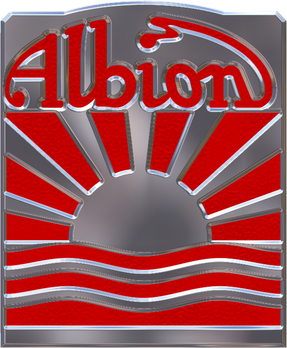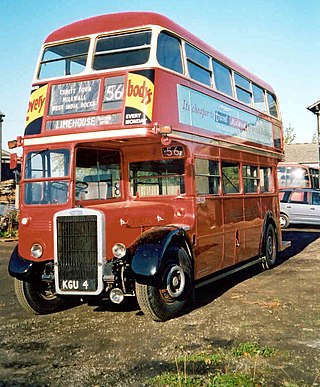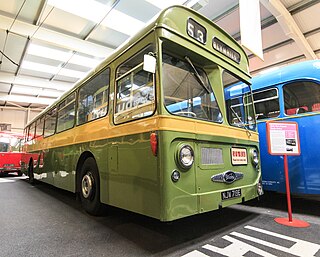
Leyland Motors Limited was an English vehicle manufacturer of lorries, buses and trolleybuses. The company diversified into car manufacturing with its acquisitions of Triumph and Rover in 1960 and 1967, respectively. It gave its name to the British Leyland Motor Corporation, formed when it merged with British Motor Holdings in 1968, to become British Leyland after being nationalised. British Leyland later changed its name to simply BL, then in 1986 to Rover Group.

Associated Equipment Company (AEC) was a British vehicle manufacturer that built buses, motorcoaches and trucks from 1912 until 1979. The name Associated Equipment Company was hardly ever used; instead, it traded under the AEC and ACLO brands. During World War One, AEC was the most prolific British lorry manufacturer, after building London's buses before the war.
Plaxton is an English builder of bus and coach vehicle bodies based in Eastfield, North Yorkshire, England. Founded in 1907 by Frederick William Plaxton, it became a subsidiary of Alexander Dennis in May 2007. In 2019, the maker was acquired by Canadian bus manufacturer New Flyer which then became NFI Group.

Fageol Motors was a United States manufacturer of buses, trucks and farm tractors.

Seddon Atkinson Vehicles Limited, was a manufacturer of large goods vehicles based in Oldham, Greater Manchester, England, was formed after the acquisition in 1970 of Atkinson Vehicles Limited of Preston by Seddon Diesel Vehicles Limited of Oldham. In 1974, the firm was acquired by International Harvester, which sold it in March 1984 to the Spanish group Enasa which made it a subsidiary of Pegaso. In 1990, it became part of Iveco which used the brand for various types of specialised vehicles in the United Kingdom. The range of models produced included EuroMover, Pacer and Strato, which are aimed at refuse collection, recycling and construction operators.

Albion Motors was a Scottish automobile and commercial vehicle manufacturer.

The Ford R series was a range of single-decker bus and single-decker coach chassis, built by Ford that evolved from designs made by Thames Trader until the mid-1960s. A number of components were shared with the D-series lorry, including the engine which was mounted vertically at the front of the vehicle, ahead of the front axle so as to provide a passenger entrance opposite the driver. The original R192 and longer R226 models later became the R1014 and R1114 variants which with constant revision and upgrading had become R1015 and R1115 by the mid-1980s. In an attempt to lower the floor height of the vehicle, the turbocharged diesel engine was tilted over to one side around 1978. Synchromesh transmission was fitted as standard but some later examples were equipped with Allison automatic gearboxes to ease the driver's workload in urban areas. It ceased production in 1985.

The Leyland Titan was a forward-control chassis with a front-mounted engine designed to carry double-decker bus bodywork. It was built mainly for the United Kingdom market between 1927 and 1942, and between 1945 and 1969.

The Alexander Dennis Enviro200 is a midibus that was manufactured by TransBus International and later Alexander Dennis between 2003 and 2018. The original TransBus Enviro200 design was innovative but ultimately unsuccessful, with few being sold before the introduction of the second generation Enviro200 revived sales for the product from 2006. It was supposed to be positioned in between a minibus and a rigid single-decker bus.

Charles H Roe was a Yorkshire coachbuilding company. It was for most of its life based at Crossgates Carriage Works, in Leeds.

Barton Transport was a bus company that operated in Nottinghamshire from 1908 until 1989.

The Daimler Fleetline is a rear-engined double-decker bus chassis which was built between 1960 and 1983.

The Maudslay Motor Company was a British vehicle maker based in Coventry. It was founded in 1901 and continued until 1948 when it was taken over by the Associated Equipment Company (AEC) and along with Crossley Motors the new group was renamed Associated Commercial Vehicles (ACV) Ltd.

Thomas Harrington & Sons was a coachbuilder in the county of Sussex from 1897 until 1966, initially at Brighton but from 1930 until the end in a purpose built Art Deco factory in Old Shoreham Road, Hove.

The Daimler Roadliner was a single-decker bus and coach chassis built by Daimler between 1962 and 1972. Notoriously unreliable, it topped the 1993 poll by readers of Classic Bus as the worst bus type ever, beating the Guy Wulfrunian into second place. It was very technologically advanced, offering step-free access some 20 years before other buses; as a coach, it was felt by industry commentators to be in advance of contemporary UK designs.

The Daimler Freeline was an underfloor-engined bus chassis built by Daimler between 1951 and 1964. It was a very poor seller in the UK market for an underfloor-engined bus and coach chassis, but became a substantial export success.

The Leyland Tiger was a heavyweight half-cab single-decker bus and coach chassis built by Leyland Motors between 1927 and 1968, except the period of World War II.

Coventry Corporation Transport was the operator of trams and motorbuses in Coventry, Warwickshire from 1912 to 1974. The operations of Coventry Corporation Transport passed to West Midlands Passenger Transport Executive in the local government reorganisation of 1974.
The AEC Renown was the name given to three distinct forward control bus chassis manufactured by the Associated Equipment Company (AEC) at different periods between 1925 and 1967. All were of the front-engine, rear-wheel-drive layout. The first and third types had two axles, the second had three. Each was intended to be fitted with bodywork by an outside coachbuilder – single deck for the first type, double deck for the third, whilst the second could be bodied in either form.

















